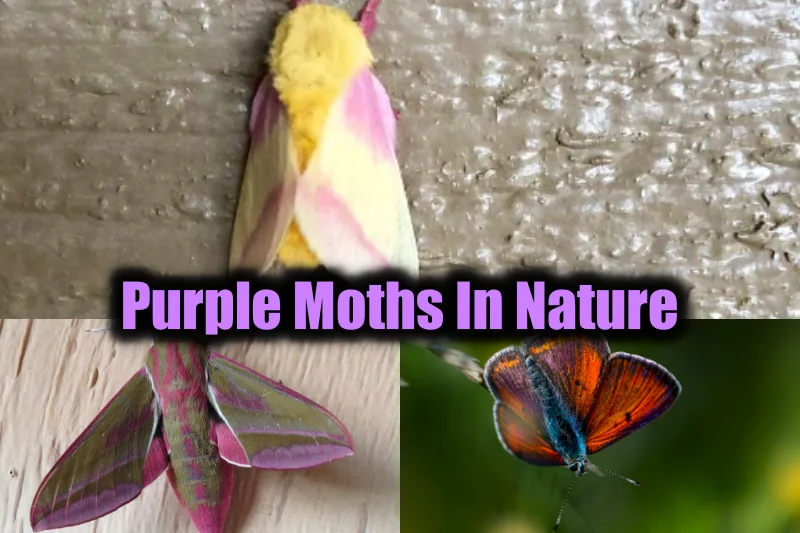While many of you may have heard of purple butterflies, have you ever wondered what a purple moth would look like or if they even exist?
Although uncommon, there are indeed very few purple moths found in nature. This purple hue gives them a distinct appearance, whether they are in flight or at rest.
Interestingly, within the same species, different sexes can exhibit two distinct colorations due to a high level of sexual dimorphism. This not only aids in their mating process but also makes it easier for wildlife enthusiasts to identify them.
Today, we present to you a comprehensive list of 19 of the most fascinating purple moths in nature. While most of them prominently display a purple hue on their bodies, some may have subtle streaks or splashes of purple.
It’s also important to note the significant changes observed in these species during their larval and moth stages. These variations, coupled with their unique colors, contribute to the moths’ distinct appearances and life cycles.
19 Most Fascinating Purple Moths In Nature
1) Purple Shot Copper
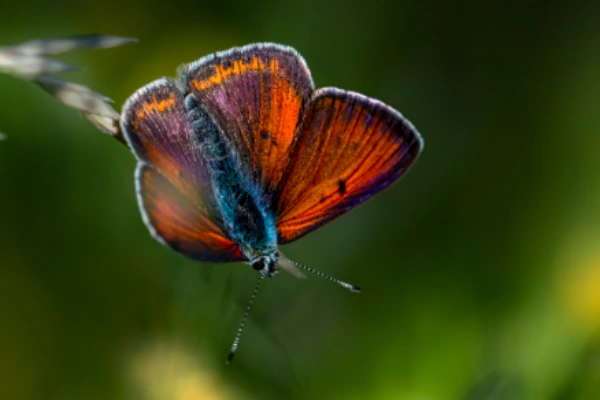
| Scientific Name | Lycaena alciphron |
| Identification | A high degree of sexual dimorphism and females and males look very different |
| Geographic Location | Europe, Morocco, and Turkey |
Purple-shot copper exhibits strong sexual dimorphism in terms of wing coloration. Males boast the vibrant purple upper wing surface, females have a completely different appearance.
The purple hue is a result of the interaction of light with specialized scales present on their wings. Female moths have brown upper wings adorned with black spots.
Both males and females have submarginal spots on their rear wings creating an even vibrant appearance.
Purple shot copper is usually found in areas at elevations between 500 and 900 meters.
2) Granny’s cloak moth
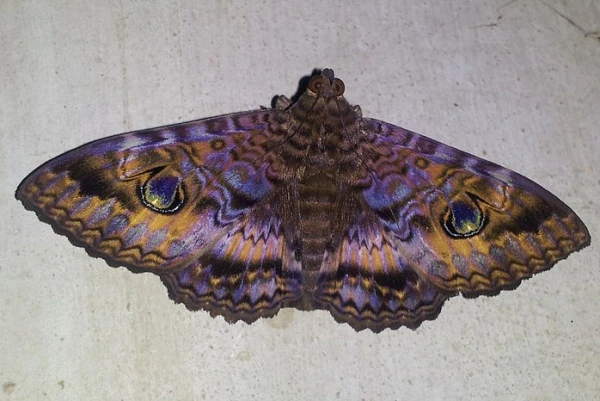
| Scientific Name | Speiredonia spectans |
| Identification | Wingspan is about 70 mm |
| Geographic Location | North-eastern Australia and Tasmania |
Granny’s cloak moths have hair on their wings, which when seen at a right angle and with direct light applied, appear purple.
Despite their overall modest brown coloration, when they are in flight or exposed to light, they give a visually striking.
Cloak’s wings have the appearance of eyes, which is an example of mimicry.
They are primarily nocturnal, allowing them to avoid many of their daytime predators.
Granny’s cloaks have significantly evolved their hearing to evade predators like bats.
3) Lily caterpillar Moth
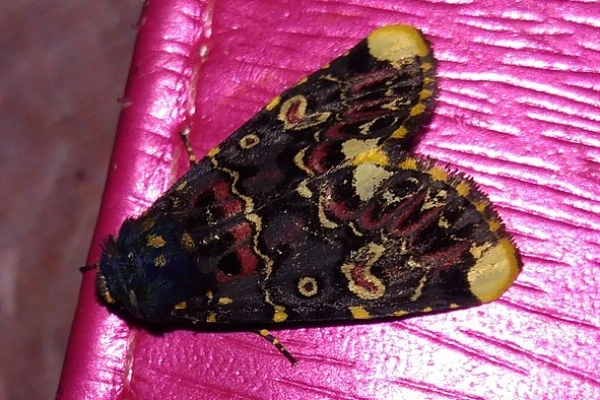
| Scientific Name | Polytela gloriosae |
| Identification | Blue-black head and thorax with orange antennae |
| Geographic Location | Sri Lanka, India and Indonesia |
Indian Lily Moth’s caterpillar moths are particularly eye-catching as they display beautiful shades of purple and red.
They also exhibit a range of colors, including pinks, yellows, and whites on their body.
While they are known for their vibrant colors and attractive appearances, they also contribute to the ecological balance by pollinating various plant species, particularly those that bloom at night.
4) Southern Purple Mint Moth
| Scientific Name | Pyrausta laticlavia |
| Identification | Purple moth with a wingspan of 17 mm |
| Geographic Location | The United States |
Southern purple mint moth has reddish-purple wings adorned with brownish-yellow bands.
In some individuals, the purple areas may appear brown, adding variability to their wing coloration.
Despite their small stature, their distinct purple wings make them stand out in their habitat.
Purple Mint moth’s larvae feed on rosemary which might have a connection with the purple coloration of the adult moths.
Southern purple mint moths have a flight season that typically spans from June to August.
5) Elephant Hawk Moth
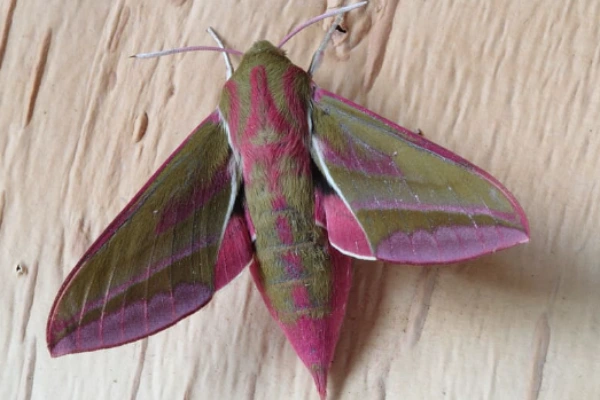
| Scientific Name | Deilephila elpenor |
| Identification | Olive-pink wing color |
| Geographic Location | Central Europe, British Columbia, and Canada |
Elephant Hawk Moth may not be predominantly purple but they exhibit a combination of colors that includes olive-brown wings outlined with pink.
This combination of colors creates an illusion of purple when viewed under sunlight.
Hawk Moth possess highly sensitive eyes that allow them to see color even in low-light conditions, particularly at nighttime.
This development in the eyesight helps them locate and feed on nectar from flowers during the night.
Their ability to see color and distinguish between various wavelengths in low light conditions helps them locate the correct flowers for feeding.
6) Inornate Pyrausta Moth
| Scientific Name | Pyrausta inornatalis |
| Identification | Forewings are of uniform color |
| Geographic Location | The United States |
Though not purely purple, under sunlight they appear pale violet-purple.
Inornate moths have a uniform light vinous (wine-colored) red or reddish-pink forewings.
The inornate pyrausta moth typically has a wingspan measuring about 13 mm. This moth species is primarily found in the United States.
The larvae of the inornate pyrausta moth feed on Salvia species, including Salvia farinacea.
7) Common Crimson-And-Gold Moth
| Scientific Name | Pyrausta sanguinalis |
| Identification | Purple-colored moth with purple-crimson markings |
| Geographic Location | Western Europe and Finland |
The most distinctive feature of the crimson and gold moth is the vibrant purple markings on its wings.
The purple coloration is particularly concentrated in specific wing areas, creating an eye-catching pattern.
Along with purple markings, these moths also showcase a combination of colors on their wings.
They feed on sage, rosemary, and thyme and the selection of these plants may influence the availability of pigments that contribute to their distinctive purple coloration.
8) Volupial Mint Moth
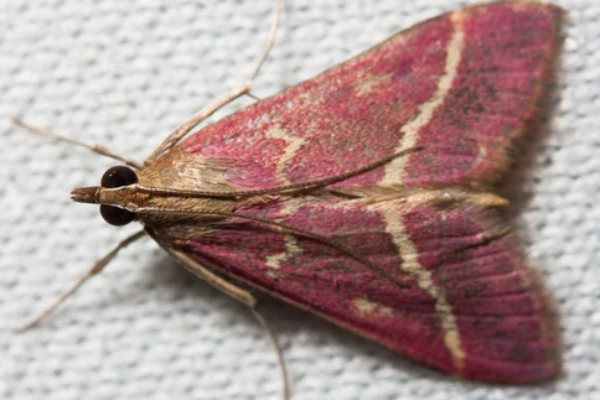
| Scientific Name | Pyrausta volupialis |
| Identification | Wingspan is around 8-10.5 mm with purple-violet forewings and white markings |
| Geographic Location | North America |
The Volupial pyrausta moth is characterized by the dark purple coloring that sets it apart from other moth species and contributes to its unique appearance.
These moths are relatively small, with a wingspan measuring approximately 8 to 10.5 mm.
The Volupial pyrausta moth is often found around various types of wild and cultivated mint plants.
This species has a close relationship with mint plants, serving as important hosts or nectar sources for the moth.
9) Purple-Barred Yellow
| Scientific Name | Lythria purpuraria |
| Identification | Day-flying species with multiple wing patterns |
| Geographic Location | Western Europe to Siberia, Russia, Ukraine, Turkmenistan, and Kazakhstan. |
The purple-barred yellow moth has two red-purple transverse lines on their green-yellow forewings.
These purple markings contrast sharply with the green-yellow background, creating a visually striking appearance.
They also possess a remarkable camouflage strategy, mimicking a dried leaf helping them evade their predators.
Unlike the moths discussed earlier, the purple-barred yellow is a day-flying species. Their purple coloration likely plays a role in attracting potential mates.
10) Raspberry Pyrausta Moth
| Scientific Name | Pyrausta signatalis |
| Identification | Bright pink-purplish forewings with white lines. |
| Geographic Location | North America |
The raspberry pyrausta moth is known for its striking and vibrant pink-to-purplish coloration.
Along with the distinct purplish hue, they also have white antemedial and postmedial lines, as well as a white discal spot on the forewings.
These contrasting white patterns create an attractive and easily identifiable appearance.
The larvae of the raspberry pyrausta moth feed on Monarda species, including Monarda fistulosa.
Their feeding habits have a great impact on their distinctly colored wings.
11) Oak lantern moth

| Scientific Name | Carcina quercana |
| Identification | Yellowish-green body with a thin purple line running down its body |
| Geographic Location | Europe and North America |
Oak lantern moth’s forewings are light brown but often have a distinctive purple-tinged hue.
Alongside their purple-tinged forewings, these moths feature intriguing yellow blotches and markings.
Another distinguishing feature is the yellow blotch along the costa near the base of the forewings and another beyond the middle that makes them stand out.
The larval stage of Carcina quercana is characterized by a pale green body and does not display purple coloration.
12) Pink-Striped Oakworm Moth
| Scientific Name | Anisota virginiensis |
| Identification | Females are larger than males with distinct purplish-red forewings |
| Geographic Location | Canada and the United States |
They display a significant degree of sexual dimorphism in terms of their wing coloration.
While the male Pink-striped Oakworm Moth’s wings are purplish brown the female has a purplish red hue to them.
There is also a distinct and vibrant purple band or stripe that runs along the wing margins.
Both male and female Pink-striped Oakworm Moths have wings that are covered in thin scales. Pink-striped Oakworm Moths are commonly found in oak woodlands.
13) Western Sheep Moth
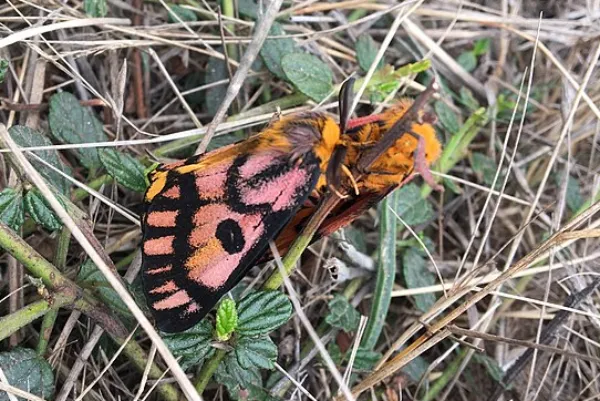
| Scientific Name | Hemileuca eglanterina |
| Identification | Slender body with pinkish-purple forewings. |
| Geographic Location | Western North America |
Sheep moth exhibits a range of colors, with the forewings being described as yellow-orange, cream, or even pink.
While purple is not a dominant color, some individuals may display pinkish hues which appears purple under sunlight.
Both the forewings and hindwings of the sheep moth have distinctive yellow to yellowish-orange coloration. The sheep moth larvae, in their early stages, are predominantly black.
14) Ernestine’s Moth
| Scientific Name | Phytometra ernestinana |
| Identification | Found year round in Florida with a wingspan of 18 mm |
| Geographic Location | North America |
Ernestine’s Moth shows the presence of purple stripes along its dark yellow forewings.
These stripes create a visually appealing contrast against the yellow background, making the moth easily recognizable.
In addition to the purple stripes on its wings, Ernestine’s Moth has a body that incorporates multiple colors, including yellow, brown, and purple making them stand out even further.
Compared to other purple moths, Ernestine’s Moth falls into the medium to large size category, with a maximum wingspan of approximately 18mm.
15) Mint-loving pyrausta moth
| Scientific Name | Pyrausta acrionalis |
| Identification | Deep rose – violet forewings with yellow borders |
| Geographic Location | Eastern North America |
The Mint-loving Pyrausta Moth displays a distinct purple coloration, particularly on its forewings.
In addition to the purple coloring, the forewings of the Mint-loving Pyrausta Moth exhibit contrasting yellow borders along the edge.
These intricate details provide the mint-loving moth a further enhanced look.
The moth’s wing shape is triangular, which, when combined with its purple and yellow coloration, makes it easy to identify in its habitat.
16) Purple Fairy Moth
| Scientific Name | Adela purpurea |
| Identification | Purple hue present in several parts of their body |
| Geographic Location | North America and Canada |
Their wings, body, or other parts often display various shades of purple, which is a dominant and defining color in their appearance.
Adult Adela purpurea moths have been observed visiting willow blossoms.
Their interactions with purple-hued flowers of the Willow tree have potentially emphasized their purple coloration. These moths are active during specific seasons.
17) Rosy maple moth
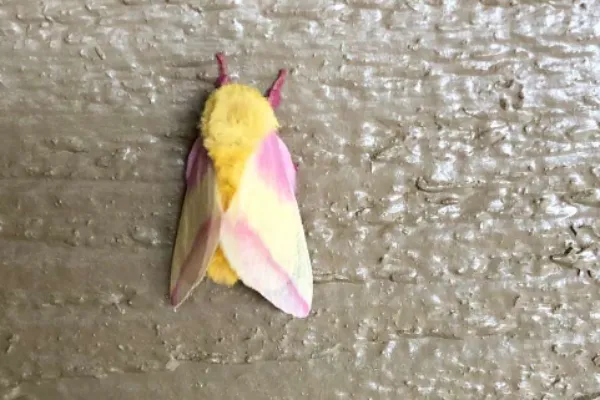
| Scientific Name | Dryocampa rubicunda |
| Identification | Wooly body with purplish-pink wings. |
| Geographic Location | North America |
The most common and eye-catching coloration of the Rosy Maple Moth includes various shades of pink and yellow.
They can also be found in variety of hues including some purples, whites, and creams.
Males have narrower wings and bushier antennae, which are used to detect female pheromones during mating.
In their larval stage they are neon green with white stripes and striking red or orange heads.
The beautiful amalgamation of colors on their body makes them a captivating and visually appealing member of the Lepidoptera family.
18) Purple thorn
| Scientific Name | Selenia tetralunaria |
| Identification | Dark brown to purplish forewings |
| Geographic Location | Europe and Britain |
The Purple Thorn has a rich, purplish hue on their wings making them stand out.
This coloration is especially concentrated towards the base of the wings.
Another striking feature of the Purple Thorn is the comma-shaped white mark on both wings. This white mark adds to the beauty of the moth.
Purple thorns have angular wings, giving them a distinct and somewhat geometric appearance. They also exhibit notable seasonal variation in size and color.
19) Fairy Longhorn Moth
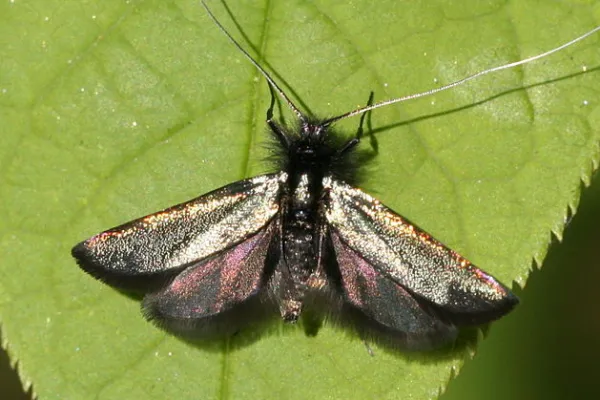
| Scientific Name | Adela trigrapha |
| Identification | Adult males have long antennae (three times the size of their forewings!) with large eyes |
| Geographic Location | Western North America |
Adela trigrapha has purple hindwings. Along with the purple hindwings, they have a bright metallic blue forewing.
This combination of blue and purple hues creates a visually captivating appearance.
They also showcase three white lines on their forewings beautifully contrasting against the purple and blue wings.
Conclusion
This concludes yet another informative article about the beautiful purple moths found around you! As we’ve already learned, the majority of them are located in the United States and its neighboring countries, making them a species concentrated in a particular area and therefore quite rare.
Most of these species showcase distinct variations in their color patterns and distribution. These bright and vibrant colors in the moths serve as a form of defense against predators. These hues can mislead potential predators into believing that the moths are toxic or not suitable for consumption, thus enhancing their chances of survival.
Also Read:

Hi everyone, my name is Shawna, and I’ve always been fascinated by the fascinating diversity of flora and fauna that our nature has in it. I am currently studying biotechnology and am particularly interested in animal biotechnology, delving into the intricate processes that define their true nature and uniqueness.
